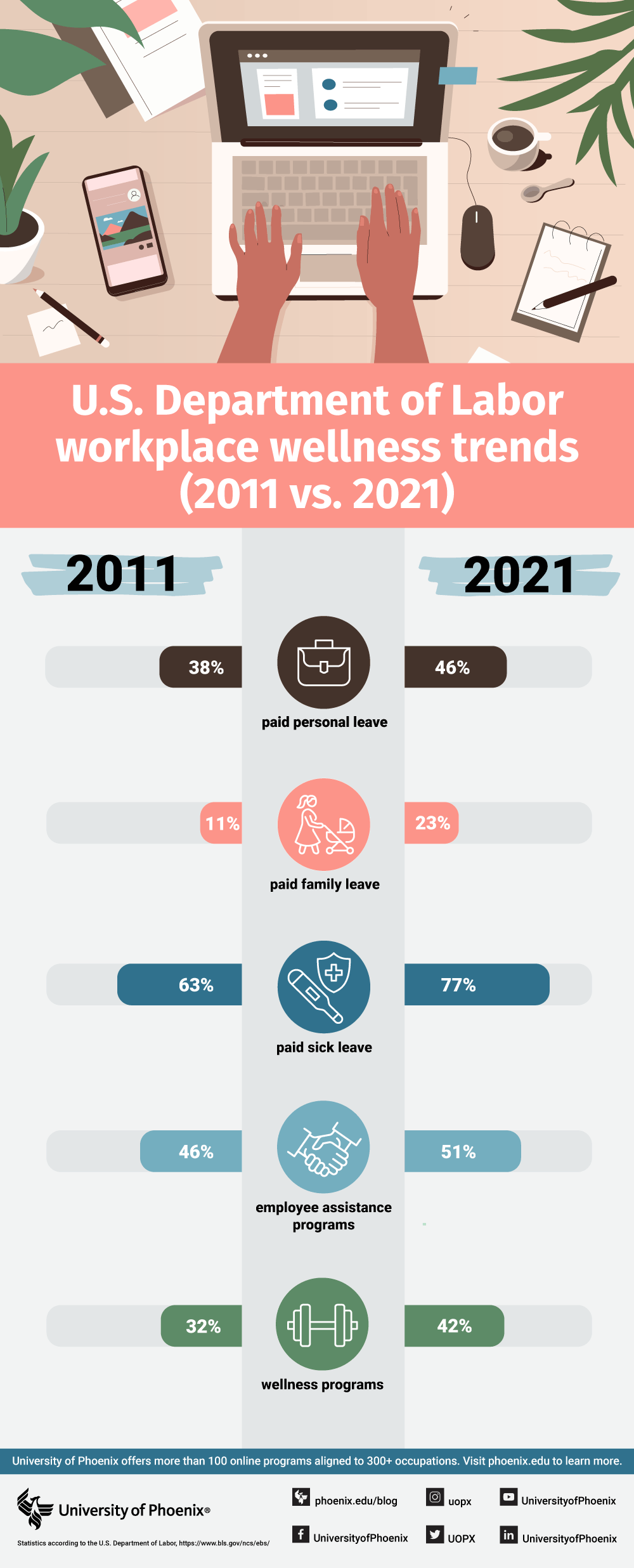How to improve workplace wellness

Written by Laurie Davies

Reviewed by Jessica Roper, MBA, director of Career Services at University of Phoenix

More than a paycheck
If the iconic work songs of the 1980s were “9 to 5” and “Working for the Weekend,” the anthem of today’s employee seems to be a spa remix about workplace wellness.
It’s not that today’s employees are soft. In fact, it’s just the opposite. They are advocating more vocally for things like work-life balance, wellness incentives and mental health resources. These things help work add up to more than just a paycheck.
Read on to understand how to gain leverage in today’s job-seekers’ market.
The Great Reshuffle
In impressive numbers, today’s employees are making job changes. A record number of Americans, 4.5 million, quit their jobs in November 2021, followed by just a slight downturn in December 2021 of 4.3 million. That’s almost 9 million jobs in two months.
Where are those workers going? In a pattern business analysts are calling the Great Reshuffle, employees are taking control of the conditions they’ll work in and the benefits that are meaningful to them. They’re quitting, evaluating and reconnecting with the workforce on their terms.
As a result, a tight labor market has companies offering everything from hiring bonuses and higher salaries to better workplace wellness plans and more flexible work schedules. (According to the U.S. Department of Labor, 14% of private-sector workers had flexibility in their work schedules in March 2021.)
“Employees understand they have options. People were thankful just to have a job in prior years, but that’s not the case in today’s job market. Employees want work-life balance and jobs where they feel like they are making a difference,” says University of Phoenix Career Advisor Ricklyn Woods.
Employers are taking notice. According to data from the U.S. Bureau of Labor Statistics (BLS), between 2011 and 2021, employers in the private sector increased paid time off and improved access to wellness programs and employee assistance programs, which offer confidential services for substance abuse and relationship challenges as well as help with financial, legal or adoption needs.

Workplace wellness
According to the U.S. Chamber of Commerce, employees who participate in workplace wellness programs tend to be fitter and more productive and have better morale. But what exactly is workplace wellness? While most people think of employee healthcare plans or fitness incentives, three broad areas fall under this umbrella:
Physical health
- Discounted or paid gym memberships
- Yoga classes or fitness clubs
- Bonus incentives for completion of health assessments or fitness goals
- On-site farmers markets or health fairs
- Access to dietitians
Mental health
- Employee assistance programs for employees and immediate family
- App subscriptions to help with sleep, calm and stress reduction
- Emphasis on using paid time off (PTO)
Flexibility
- Additional PTO
- Flexible hours
- Built-in breaks
- Remote or hybrid work
Woods urges her clients — those who take advantage of University of Phoenix’s no-cost, career coaching available to current students and graduates — to ask about the wellness benefits, including mental health benefits. While taking a “mental health day” used to be a punchline, it’s not anymore.
Even though job-seekers have leverage right now, these can be tricky conversations. Woods offers a few questions as starting points:
- What’s the culture in regard to workplace wellness here?
- How soon would I become eligible for wellness benefits, such as A or B? (Insert the ones that matter most to you.)
- What is it like taking PTO here? How is that perceived?
- My mental health is just as important to me as my physical health. Would the organization value my taking time off to regroup if needed?
Yes, I want more wellness!
These questions may just be starters when it comes to advocating for yourself. “Forget asking Google the top 10 questions to ask in an interview. Ask the questions that mean the most to you. At the end of the day, your well-being is your well-being,” Woods says. “If you raise a question about mental health benefits or time-off policies that result in you not getting the job, you probably don’t want that job.”
Although negotiating for better workplace wellness is possible while you’re in a job — usually by passing ideas along to decision-makers or to HR — Woods says it may be easier to apply to companies that have the workplace wellness culture you seek.
“Some of these things aren’t up for negotiation. Companies either have a wellness plan or they don’t,” Woods says. Here’s how to find the ones that do:
- Research company website and job site postings. Study the language. See how their values are expressed.
- Connect with employees. Find someone on your preferred job networking site who works for the company and see if they’ll answer a few questions about their experience.
- Be educated. “Some clients operate in a silo in a job search. It’s them versus the world, so to speak,” Woods says. “There are articles about what companies are doing to stay competitive. What is Forbes saying? Educate yourself.”
- Read reviews. Sites such as Glassdoor and Indeed feature employee reviews. “Some people leave meaningful comments, but utilize those sites with caution. Some employees have an ax to grind,” Woods says.
Finally, you may be wondering whether you should simply ask for more money if a company doesn’t have a wellness benefit you want. Woods suggests you might be happier in the long run if you find an employer who offers the benefit.
“I don’t tend to advise clients in the direction of ‘If you can’t get this, get more of that.’ If one company doesn’t offer what you want, another company probably does,” Woods says.
At the end of the day, it’s important to know what you need to feel successful and perform good work. Knowing your bottom line will likely help your company’s bottom line.
In that way, 9 to 5 — this time the movie — might have been 40 years ahead of its time. In the hit 1980 film, the fictional, vanilla-named “Consolidated Companies” saw a 20% increase in productivity when the central characters instituted in-office day care, flexible hours, job sharing and equal pay for women and men.
Sometimes life imitates art. As the Great Reshuffle continues, let’s hope that proves true.

ABOUT THE AUTHOR
A journalist-turned-marketer, Laurie Davies has been writing since her high school advanced composition teacher told her she broke too many rules. She has worked with University of Phoenix since 2017, and currently splits her time between blogging and serving as lead writer on the University’s Academic Annual Report. Previously, she has written marketing content for MADD, Kaiser Permanente, Massage Envy, UPS, and other national brands. She lives in the Phoenix area with her husband and son, who is the best story she’s ever written.

ABOUT THE REVIEWER
Jessica Roper, University of Phoenix director of Career Services, is a seasoned leader with over 15 years of experience in leadership within higher education. She has honed her expertise in student services and career development and is passionate about helping others discover and refine their skills.
This article has been vetted by University of Phoenix's editorial advisory committee.
Read more about our editorial process.
Read more articles like this:


